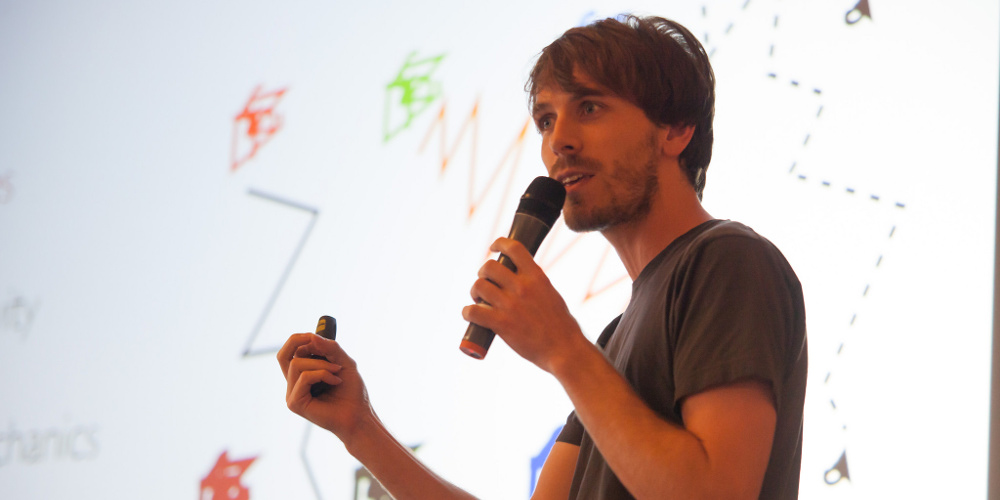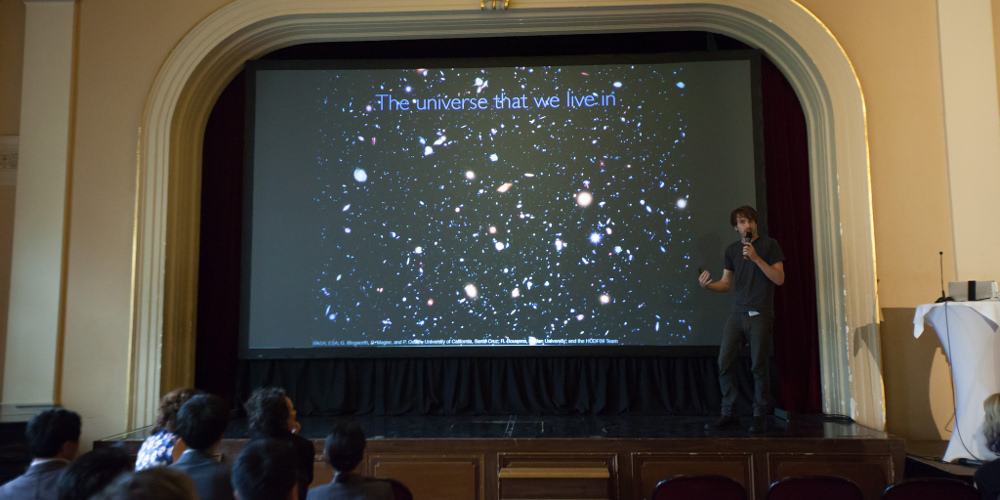
Tom Melia (Credit: Florian Voggeneder)
Collide@CERN is currently in its third year. Within this framework Tom Melia, theoretical particle physicist, is scientific inspiration partner of Ryoji Ikeda during his Collide@CERN residency. Collide@CERN aims at colliding art and science through bringing outstanding artists and scientists in contact that should lead to innovative outcomes and interesting experiences for both. In this interview he talks about his experience during the residency program.
Tom, you are Ryoji Ikeda’s scientific inspiration partner during his time at CERN. Why have you decided to participate in this program? What are your motivation, personal interest and perspective on that?
Tom Melia: Ryoji’s projects are inspiring, his music moves me, and I was interested in meeting him and talking about what it is he is trying to do and what motivates him. I knew Ryoji had an interest in mathematics, and I love discussing maths and physics with people who are not formally trained as mathematicians or physicists, finding out which things in my field resonate the most when approached from what is often a very different perspective. I also play and compose music, so that resonated too. The program sounded fun.
What is your perspective on the collision of art and science?
Tom Melia: I don’t really find that there is any sharp distinction between art and science. So less of a collision from my perspective. Having said that, I often love artistic projects which are directly inspired by science, so in this sense, I think drawing upon scientific ideas/concepts can really work. Ryoji’s works are a great example of this.
What is the process of being a scientific inspiration partner for an artist? How is it to be Ryoji Ikeda’s scientific inspiration partner?
Tom Melia: Ryoji was very keen to become immersed in the physics performed at CERN and spent a lot of time studying from books and articles. We would then meet up, with a starting point being to discuss the things he had been reading, and then take the conversation from there.

Tom Melia (Credit: Florian Voggeneder)
Do you want to tell a little more about your work and how this collision of art and science connects to your work in your opinion?
Tom Melia: I’m a theoretical particle physicist and my research is on understanding how the universe behaves at a fundamental level. I explore aspects of the quantum theory which we know describes nature extremely well – the standard model – and use this theory to make predictions for what we (do/should/might) see at the LHC. The connection is that both artists and scientists are at heart, in my opinion, doing the same thing – trying to explore, understand and interpret the world we find ourselves in. Different frameworks, different perspectives, but the same questions. Some of my work is very visual, with a heavy reliance on drawings and abstract diagrams to understand mathematical concepts, so there is a direct connection there too.
[youtube=https://www.youtube.com/watch?v=omDK2Cm2mwo&w=610]
Did this experience, maybe you want to call it a reminder of approaching the world with an artistic lens, change something for you?
Tom Melia: It was fantastic meeting Ryoji – he’s curious in a way I recognise from my scientist friends and colleagues, and I felt a connection on this level strongly. I am enjoying talking to people who are inspired by the world around them. And I certainly got a fresh dose of inspiration from the program; it’s always nice to be reminded that physics can and should be creative, and how important it is not to lose sight of that.
Talk of Ryoji Ikeda at the Ars Electronica Residency Network Panel, at Ars Electronica Festival 2014: http://talksandlectures.aec.at/?id=347
